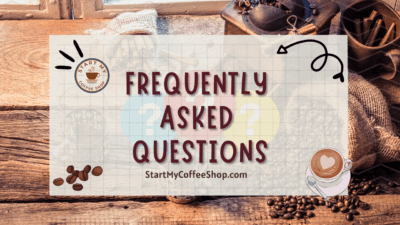Coffee, a beloved elixir that fuels the dreams and ambitions of millions, presents a tantalizing opportunity for aspiring entrepreneurs. Establishing a coffee shop not only satisfies the caffeine cravings of customers but also creates a social hub where people can gather, unwind, and indulge in their love for aromatic brew.
Crafting a coffee shop business plan includes showing your understanding of the market, competition, marketing strategies, operations, and financial projections. Highlight your unique selling points and investment requirements. Secure the support needed to turn your coffee shop dream into a thriving reality.
In this article, I will delve into the key elements of a well-crafted coffee shop business plan and explore how to attract investors to support your venture.
1. Executive Summary
Begin by outlining your business concept, and clearly articulating the unique value proposition that sets your coffee shop apart. Highlight the key elements that make your concept appealing, whether it’s a specialty coffee offering, a unique atmosphere, or an innovative approach to customer service.
Next, delve into your target market. Describe the demographics, preferences, and behaviors of your ideal customers. Discuss the market size and growth potential, demonstrating that there is a demand for your coffee shop in the chosen location.
Emphasize your competitive advantage in the market. Identify and analyze your competitors, highlighting what sets your coffee shop apart and positions it for growth. This could be factors like a prime location, exclusive partnerships, a strong brand identity, or a superior customer experience.
Financial projections are a crucial component of the executive summary. Summarize the projected revenue, expenses, and profitability over a specific timeframe. Showcase your understanding of the industry’s financial dynamics, such as gross profit margins, operational expenses, and breakeven points.
Finally, outline the investment required to bring your coffee shop to life. Clearly state the amount of capital you are seeking and how it will be utilized. This transparency reassures potential investors that their funds will be put to good use and that you have a solid plan for achieving profitability.
In essence, the executive summary acts as a persuasive tool to capture the attention of potential investors. It presents a compelling case for the viability and profitability of your coffee shop by summarizing its key components, highlighting its unique aspects, and demonstrating your financial acumen. A well-crafted executive summary sets the stage for a great coffee shop business plan.
2. Business Description
In the detailed description section of your coffee shop business plan, it is crucial to paint a vivid picture of your establishment, capturing its essence and distinguishing features. Start by providing the name of your coffee shop, which should resonate with your target audience and reflect the overall brand image you want to create.
Next, describe the location of your coffee shop, emphasizing its accessibility, visibility, and potential foot traffic. Discuss the neighborhood or area, highlighting any unique characteristics or advantages that make it an attractive location for your target market.
Elaborate on the theme and ambiance of your coffee shop. Whether it’s a cozy and rustic atmosphere, a modern and minimalist design, or a vibrant and eclectic vibe, clearly conveys the mood and aesthetic you aim to create. Use descriptive language to transport potential investors into the space, evoking a sense of comfort and appeal.
Detail the type of coffee you will serve, highlighting its quality, sourcing, and preparation methods. Discuss any unique or specialty coffees that will be part of your menu, showcasing your commitment to offering a distinctive coffee experience. Additionally, outline the menu offerings beyond coffee, such as pastries, sandwiches, or other specialty items, highlighting their appeal to your target market.
Identify and highlight any unique selling points that differentiate your coffee shop from competitors. This could be anything from signature drinks, sustainable practices, local partnerships, or a focus on community engagement.
Discuss your target market in detail, outlining their preferences, demographics, and psychographics. Show that you have conducted thorough research and understand their needs and desires. Additionally, demonstrate your knowledge of the local coffee culture, emphasizing how your coffee shop will fit into and enhance the existing coffee scene.
3. Market Analysis

Begin by analyzing the demographics of the area where your coffee shop will be located. Consider factors such as age, income levels, education, and lifestyle choices. This information helps you understand your target audience and tailor your offerings to their specific desires.
Consumer trends play a significant role in the coffee industry, so it is crucial to stay informed about the latest preferences and behaviors. Research the evolving coffee trends in your target market, such as a growing interest in specialty or ethically-sourced coffee, the demand for innovative brewing methods, or the popularity of plant-based milk alternatives.
Identify and analyze your competitors in the local area. Study their strengths, weaknesses, pricing strategies, and customer base. Assessing the competition helps you understand their market positioning and identify areas where you can differentiate your coffee shop. By offering unique features, superior quality, or exceptional customer service, you can carve out a niche for your business.
In addition to understanding the market dynamics, outline strategies for reaching and engaging your target audience. This includes marketing initiatives such as social media campaigns, partnerships with local businesses, community events, or loyalty programs.
Read more about: Average Costs for Coffee Startup: Bean Counting 101
4. Competitive Analysis
Start by identifying the coffee shops in the local area. Evaluate their offerings, menu selections, and pricing strategies. Take note of their target audience and customer base. This analysis will help you identify gaps and opportunities in the market that you can capitalize on.
Study the marketing strategies employed by your competitors. Assess their online presence, social media engagement, and branding efforts. By understanding how they promote their coffee shops, you can identify areas where you can stand out and develop effective marketing strategies that resonate with your target audience.
Evaluate the customer experience provided by your competitors. Consider factors such as service quality, ambiance, and convenience. Identify areas where you can offer a superior experience, whether it’s through exceptional customer service, a unique atmosphere, or innovative technologies that enhance the coffee experience.
Highlight your unique features and value propositions that set your coffee shop apart from the competition. This could include specialized brewing methods, ethically sourced beans, a focus on sustainability, or partnerships with local suppliers. Emphasize how these aspects will attract customers and create a loyal customer base.
5. Marketing and Sales Strategies
Establish a professional website that showcases your coffee shop’s offerings, values, and unique selling points. Leverage social media platforms to engage with your target audience, share compelling content, and run targeted advertising campaigns. Utilize search engine optimization (SEO) techniques to ensure your coffee shop ranks high in relevant online searches.
In addition to online strategies, consider offline promotional activities. Collaborate with local businesses to cross-promote your products or services, such as offering exclusive discounts to their customers. Participate in community events and sponsor local initiatives to raise awareness and foster a positive brand image.
Highlight customer engagement initiatives in your marketing plan. This can include loyalty programs, customer feedback mechanisms, and personalized offers. Building a strong relationship with your customers is key to their satisfaction and loyalty.
Present a sales forecast that outlines the expected revenue streams and customer acquisition strategies. Detail the average transaction value, projected customer growth, and retention rates. This will demonstrate to investors that you have a clear plan for generating revenue and expanding your customer base.
6. Operations and Management

Outline the organizational structure, clearly defining the roles and responsibilities of key team members. This includes positions such as the manager, baristas, kitchen staff, and support staff. Highlight the qualifications and experience required for each role, emphasizing how the team’s expertise will contribute to the improvement of your coffee shop.
Detail your hiring and training processes to demonstrate your commitment to assembling a skilled and knowledgeable workforce. Explain your recruitment strategies, employee onboarding procedures, and ongoing training programs. Investors will be reassured knowing that you have a plan in place to attract, develop, and retain talented individuals.
Describe your supply chain management and procurement strategies. Highlight your relationships with coffee suppliers, emphasizing their reputation, quality, and sustainability practices. Discuss how you will ensure a consistent supply of high-quality coffee beans, ingredients, and other necessary supplies.
Investors will be looking for evidence of your ability to effectively manage operations while maintaining quality and customer satisfaction. Showcase your commitment to operational excellence by detailing your quality control processes, customer service protocols, and measures to ensure cleanliness and hygiene.
Read more about: Average Cost to Start Up a Coffee Shop: Unveiling the Monetary Commitment
7. Financial Projections
Start by outlining the start-up costs, which include expenses such as leasing or purchasing a location, acquiring equipment, and obtaining necessary permits. Break down these costs in detail, demonstrating your thorough understanding of the investment required to establish your coffee shop.
Next, provide an overview of the monthly expenses that will be incurred in running your coffee shop. This includes rent or mortgage payments, utilities, employee salaries, inventory costs, and marketing expenses. Presenting these expenses in a clear and organized manner shows potential investors that you have meticulously considered the ongoing financial obligations associated with your business.
Revenue forecasts are another crucial component of your financial plan. Based on market research and analysis, project the expected sales and revenue for your coffee shop over a specific timeframe. This should consider factors such as customer traffic, average transaction value, and seasonality.
Lastly, provide projected profitability figures over the designated timeframe. This includes estimating your gross profit margin, operating expenses, and net profit. Show potential investors that you have conducted thorough research and analysis to develop these projections, making it clear that your plan is grounded in realism and industry knowledge.
8. Investment Requirements
When outlining the investment requirements for your coffee shop, it is crucial to provide a clear and detailed breakdown of the capital you are seeking. Specify whether you are seeking funding through equity, loans, or a combination of both. This information helps potential investors understand their role and potential returns.
In addition, it is important to present the potential return on investment (ROI) and the timeline for investors to recoup their funds. Highlight the projected profitability of your coffee shop, considering factors such as projected sales, profit margins, and market trends. This will give investors a realistic expectation of the returns they can expect and the timeframe in which they can anticipate recouping their investment.
To instill confidence in potential investors, provide a thorough breakdown of how the investment will be utilized. Explain how the funds will be allocated, such as equipment purchases, leasehold improvements, marketing campaigns, and working capital. This transparency demonstrates your careful planning and ensures that investors have a clear understanding of how their funds will be put to use.
Summary
Crafting a compelling business plan for a coffee shop investment requires careful consideration of various factors, from market analysis and competitive differentiation to financial projections and investment requirements. By showcasing your passion, expertise, and understanding of the industry, you can attract investors who share your vision and are eager to be part of your coffee shop journey.
Frequently Asked Questions

Q: How much capital do I need to start a coffee shop?
A: On average, you should budget for around $100,000 to $300,000, including start-up costs and initial inventory.
Q: How can I attract investors for my coffee shop business?
A: Develop a comprehensive business plan that showcases your market analysis, competitive advantage, financial projections, and investment requirements. Present a compelling case highlighting the potential profitability and unique aspects of your coffee shop.
Q: What are some effective marketing strategies for a coffee shop?
A: Include creating an online presence through social media platforms, offering loyalty programs, partnering with local businesses for cross-promotion, hosting community events, and providing excellent customer service to generate positive word-of-mouth.
To learn more on how to start your own coffee shop, check out my startup documents here.
Disclaimer: The information provided by StartMyCoffeeShop.com (“The Site”) is for general informational purposes only. All information on the Site is provided in good faith. However, we make no representation or warranty of any kind, express or implied, regarding the accuracy, adequacy, validity, reliability, availability, or completeness of any information on the Site. Under no circumstance shall we have any liability to you for any loss or damage of any kind incurred as a result of the use of the Site or Reliance on any information provided on the Site. Your use of the Site and reliance on any information on the Site is solely at your own risk. This blog post is for educational purposes only and does not constitute legal advice. Please consult a legal expert to address your specific needs. Terms and Conditions. (https://startmycoffeeshop.com/terms-and-conditions/)

Hi! I’m Shawn Chun
My adventure in coffee began when I first launched my first coffee shop back in the early 2000s. I had to figure out so many things on my own and to make it worse within 2 years of opening two large corporate coffee chains moved in just blocks away from me!
As I saw smaller and even some larger coffee shops in the neighborhood slowly lose customers to these giant coffee chains and slowly close up shop, I knew that I had to start getting creative…or go out of business.
I (like you may be) knew the coffee industry well. I could make the best latte art around and the foam on my caps was the fluffiest you have ever seen. I even had the best state-of-the-art 2 group digital Nuova Simonelli machine money could buy. But I knew that these things alone would not be enough to lure customers away from the name brand established coffee shops.
Eventually, through lots of trial and error as well as perseverance and creativity I did find a way to not only survive but also thrive in the coffee/espresso industry even while those corporate coffee chains stayed put. During those years I learned to adapt and always faced new challenges. It was not always easy, however, in the end, I was the sole survivor independent coffee shop within a 10-mile radius of my location. Just two corporate coffee chains and I were left after that year. All told the corporate coffee chains took down over 15 small independent coffee shops and kiosks and I was the last one standing and thriving.
Along the years I meet others with the same passion for coffee and I quickly learned that it is not only “how good a barista is” that makes a coffee shop successful, but the business side of coffee as well.
Hence why I started this website you are on now. To provide the tools and resources for up and coming coffee shop owners to gain that vital insight and knowledge on how to start a coffee shop successfully.
Stick around, browse through my helpful blog and resources and enjoy your stay! With lots of LATTE LOVE!
Shawn







